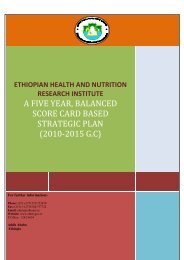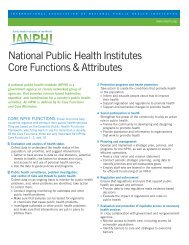Afghanistan Afghan Public Health Institute Strategic Plan - ianphi
Afghanistan Afghan Public Health Institute Strategic Plan - ianphi
Afghanistan Afghan Public Health Institute Strategic Plan - ianphi
Create successful ePaper yourself
Turn your PDF publications into a flip-book with our unique Google optimized e-Paper software.
STRATEGIC DIRECTION: IMPROVE THE NUTRITIONAL STATUS OF THE AFGHANPOPULATIONBrief Description/Rationale and Current SituationImproving the nutritional status of the <strong>Afghan</strong> population, in particular pregnant women and youngchildren, has been one of the priorities of the MoPH since 2002. Although progress has been madein lowering acute malnutrition, over 50% of <strong>Afghan</strong> children are stunted, between 5 to 10% sufferfrom acute malnutrition and an estimated 70% suffer from micronutrient deficiencies (MoPH <strong>Public</strong>Nutrition Policy and Strategy, 2009‐2013; refer to the same MoPH strategy, p.8, The ConceptualFramework of Malnutrition, adapted from UNICEF – 1992, for a better understanding of malnutritionand the causes).“An estimated 500,000 <strong>Afghan</strong> babies are born each year with intellectual impairment caused by iodinedeficiency in pregnancy … Approximately 50% of <strong><strong>Afghan</strong>istan</strong>’s children grow up with lowered immunity,leading to frequent ill health and poor growth. Cause: vitamin A deficiency … 2,600 young <strong>Afghan</strong> womenevery year (die) in pregnancy and childbirth. Cause: severe iron deficiency anemia (The MicronutrientInitiative & UNICEF, VITAMIN & MINERAL DEFICIENCY A damage assessment report forAFGHANISTAN, p. 3)There are a number of reasons for this critical situation that include:Inadequate knowledge and skills among the general population related to good health andnutrition (e.g. requirements for women during pregnancy and for young children and why theseare important for optimal growth and development)Poor dietary diversity and low micronutrient intake associated with limited quality and lowcoverage of current micronutrient interventionsExposure of the public to unsafe foods and unhygienic food practicesLimited capacity in public health nutrition among <strong>Afghan</strong> health professionals and practitionersfrom other nutrition‐related sectors (e.g. there is currently no cadre of nutritionists in<strong><strong>Afghan</strong>istan</strong> and little education among professionals from the health, agriculture, educationand social sectors about nutrition and its importance)Limited access to quality treatment for severe malnutritionInadequate Infant and Young Child Feeding (IYCF) programs and limited community outreach ofcurrent IYCF counselling and supportRecurrent food crises/emergencies and low assessment and response capacityLow availability of reliable nutrition dataWeak monitoring and evaluation of nutrition interventions<strong>Strategic</strong> Objective 1 (SO‐1): To advocate for and increase awareness about healthy eating amongthe general populationPriority Interventions:Ministry of <strong>Public</strong> <strong>Health</strong> <strong>Strategic</strong> <strong>Plan</strong>, 2011‐201522




